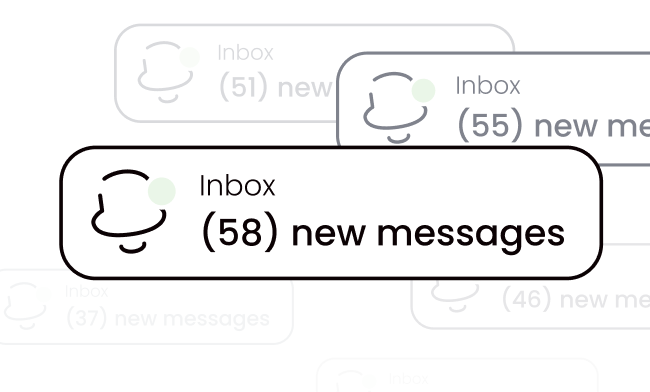Is cold email dead?
We’ve seen more changes in the cold email space in the last year than in the previous 5 years. And they’re only going to accelerate.
How we send our cold emails, write them, how we get data – everything has changed.
And, like it or not, those who don’t adapt the new way of email outreach will get left behind.
But what exactly is changing? And what can you do to thrive in cold emailing today?
For that, let’s break down cold email into 5 areas:
- Access to data
- Prospect research & personalized outreach
- Sending cold emails
- The SDR role
- Cold email tools
I’ll cover each of them in this blog post. But we’ll start with the first question that comes to mind: is cold email even worth it anymore?
Cold email is more cost-effective than ever (and getting cheaper!)
With all sales channels, your deals have to be high enough to cover the cost of the team’s salaries, infrastructure and leave a profit.
Not so long ago, cold emails made sense when the deal size was at least $2,000 (per Cold Email Manifesto by Alex Berman and Robert Indries).
But with the costs of cold email going down, I’d risk saying now it can make sense if your prices start at $1,000.
Cold email is getting easier and cheaper to scale.
At the same time, the costs of other acquisition channels are going up. Look at Google ads.
According to this Google ads report from WordStream, the cost per click increased by an average of 10% (April 2023-March 2024). The cost per lead also went up – by an average of about 25%. That leaves us with:
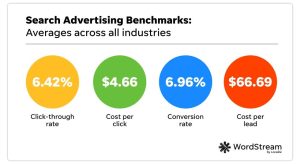
Source: WordStream
Now, look at the average costs of LinkedIn ads per this research from marketing agency WebFX:
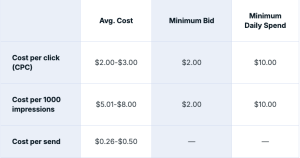
Source: WebFX
And compare that with the cost of cold emails.
Take a look at Woodpecker as an example – you can contact 500 people for $29/mo. To contact twice as many (1,000), you’d pay $49 – extra 20 bucks for twice as many opportunities.
Let’s account for your domain ($15 per year, so $1.25/mo) and a mailbox ($6), too. So:
$29 + $1.25 + $6 = $36.25
If you’re looking at the cost per 1,000 impressions and thinking, ‘hey, that’s cheaper than cold email’, let me say this: this metric is used for brand awareness ads.
If you’re running lead generation ad campaigns, you should be looking at cost per click or per send, and – of course – at cost per lead.
And according to the benchmarks by Powered by Search, the cost per lead for LinkedIn ads ranges from $15 to $350.

Source: Powered by Search
For cold email, the cost is typically lower.
Cost per lead in cold email
Let’s say you want to contact 500 people per month. That will cost you $36.25/mo.
The average reply rate is 1.9% (based on the research on our customers’ campaigns). So in this case, it’s 9.5 replies. (Let’s round it up to 10.)
On average, there’s going to be 10-20 positive replies in every 100 replies you get. So 10 replies get you 1-2 positive replies. For $36.25/month.
So it can go as low as $18.12 per lead.
Compare that to $66.69 per lead from search ads and $15-$350 from LinkedIn ads.
Also, not many other acquisition channels allow you to target your prospects as precisely as cold email. Definitely not ads or SEO marketing.
With cold email, you pick person X at company Z. That means you spend money targeting only those prospects who qualify as your ICP.
Let’s say you sell to e-commerce shops. Your list hasn’t been cleaned yet. Now you can scrape the websites on your list to check:
- if the company is still operating
- whether they’re really an e-commerce company
- what type of products they sell (electronics, clothing, shoes, etc.)
- if they have a 360 degree views of their products
- what are their terms of refunds
- and many other things
With that information, you can build very detailed ICP segments.
The only other channels that allow you the same level of targeting are cold calls and LinkedIn DMs. But emails are less intrusive than calls and scale better than LinkedIn messages. (You can also just combine all three channels.)
The ROI of cold email
Woodpecker has hundreds of lead generation agencies on board. They run campaigns for clients, so their monthly sending volumes are among the highest in the space.
For example, one European agency sends around 1 million emails a month with us. It’s a big agency with lots of clients.
They get an average reply rate of 4.1%. They get 18 replies for every $10 they spend with Woodpecker. (Each of these customers pays more, of course, but this is the metric we use internally.)
Typically, 1-2 in 10 replies are positive. For this particular customer, that’s about 2-4 leads coming in for every $10 they spend with us.
A small American agency gets 13 replies for every $10 spent with Woodpecker. That’s 1-3 leads for every $10 spent with us.
And keep in mind that the US is the most competitive market. It’s the most saturated with cold emails, which also makes it the hardest to succeed.
Another customer, a B2B marketplace with high-profile clients, gets a whopping 29 replies for every $10 spent with Woodpecker. That’s 3-6 leads for 10 bucks.
With the right strategy, you could be looking at similar results.
Here’s how.
Data is commoditized – and becoming cheaper
In business, data is a commodity. It’s one of the most valuable assets a company can have. In cold email, we use it to contact our potential new customers, segment our lists and personalize the messages.
Company, industry, country – and not much else
Not long ago, many companies could only get their prospects’:
- company name
- general industry, and
- country
If you wanted access to more specific data than that, you had to sign a contract with a data provider company.
Usually, that meant you were getting yourself locked into a year-long contract. Often an expensive one.
That left companies either spending a decent chunk of their budget on data, or sending generic emails with the “spray and approach”. That was a pain in the neck, especially for smaller businesses.
But not anymore.
Data has become cheaper than ever
Now, access to very specific and customized data has become affordable. Look at tools like Clay, Persana or Apify. You can get access to multiple data providers without signing a contract with them.
Clay also has a free option, so you can test the product even before you reach into your pocket.
These tools use a waterfall data enrichment model. They pull data from a lot of different data providers. So you can get a far richer spectrum of data at a much lower cost in one place.
Cold email senders use these data enrichment tools to:
- narrow down companies by tags (B2B, travel, finance, recruitment, etc.)
- have access to specialized databases (like Store Leads, a platform for e-commerce data)
- find company descriptions at scale
- search if the company is hiring (across different job boards)
- see what their prospects’ tech stack is
- and much, much more.
That’s a huge change. Now you don’t have to be extremely tech-savvy or spend hours to get enriched prospect data at scale.
And this opens up new possibilities.
Building detailed ICP segments
This creates the opportunity to build more precise ICP segments. So instead of “recruitment, size 51-200, country: United States”, you can get data points like:
- Recruitment, HR, team management, agency, etc.
- According to their website, their ICPs are start-ups, SMBs and investors
- What their company’s mission and culture are
- What roles they’re hiring for at the moment (including the job description which explains what they’re trying to solve with this hire)
- What the employees posted on LinkedIn in the last 90 days
And this is just a thin slice of the pie. Tools like Clay can extract many more types of data:
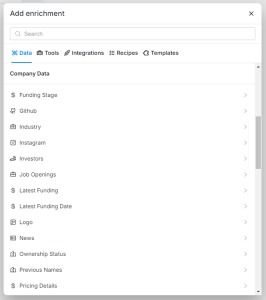
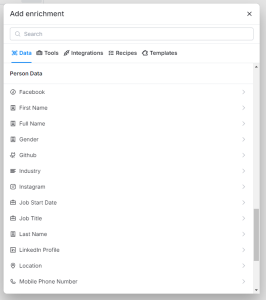
And here’s what some predefined AI-driven flows look like. An AI agent looks for this data by googling, visiting websites, etc. and collects the information like a human would do.
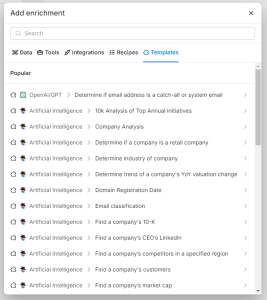
With data like this, you can make sure you’re getting very targeted in your email campaigns. You can be more confident that you’re reaching the people you know might need your solution. And that’s a win-win scenario for you and your prospects.
Sales triggers are easier to access, too
Sales triggers, especially, can be game-changers.
They’re the signals that show a prospect/company might be entering the buyer phase. These could be events like:
- Hiring for specific job titles that suggest a need for your solution
- Is the company growing? (based on headcount, revenue, etc.)
- Did they release new features or products recently?
- Was there a change in management?
- Did they have an IPO recently?
A few years ago, getting sales triggers at scale was accessible only to highly technical teams. They were also often limited to a few data points.
Now, you can access that kind of data even if you don’t have a technical bone in your body. And the range is way broader.
There are even new tools laser-focused on providing sales-trigger data, like Trigify.
Data enrichment: what to do so you don’t miss out
Does commoditization and lower data costs mean there will be even more competition for attention in inboxes? You bet.
But it also means more people will take the easy way out. They’ll get the data and still churn out mass, poorly-written cold emails.

But if you do it right, the more nuanced data will allow you to send truly more relevant and timely cold emails. You’ll still win, even though there might be more competition in your prospects’ inboxes. Using the newest data enrichment tools will help you get there faster.
Your action point #1
As I mentioned, an excellent way to benefit from these tools is to create more granular ICP segments. That will then help you create more targeted email campaigns. You’ll be able to fine-tune your offer to different target customer groups with much better accuracy (instead of putting all SaaS or e-commerce companies in one target group).
And more targeted usually equals more replies.
You can create these ICP segments by reverse-engineering your current ICP:
- Single out your most successful customers
- Check what data they have in common
- Find look-alike companies with Clay or another data enrichment tool

Source: Clay
Prospect research and personalized outreach at scale
Let me guess: you (or your team) used to spend a lot of time researching prospects.
Looking them up on LinkedIn, reading their company description and 2-3 of their posts. Going to their website, checking their ICP. Googling their strongest competitors. The whole shebang. You know it. You’ve done it.
Some cold emailers don’t, and revert to “spray and pray”:

But you need to do your homework on a prospect so they know they’re the exact person you want to connect with. Otherwise, it’s a guaranteed no-reply.
Here’s some good news, though.
There’s a new way of doing prospect research – one that doesn’t take hours.
AI tech and tools that mimic human research at scale
Some experts expect that outbound will go one of two ways. Either everything will be 100% human, or each sales rep will be on a high monthly budget for tools and data:
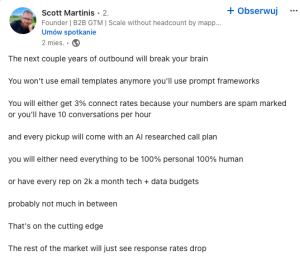
And that very well might be the case.
Using AI and other types of tools can free up your or your team’s time – big time. If you know how to use them, they can do so and help you appear human every step of your cold outreach process.
For AI, context and data are king. The higher-quality input you feed them, the higher quality output you get out.
Give it accurate context and high-quality data in a good prompt, and you can get quite a specialized result.
And since access to different data points from multiple data providers is now so commoditized, it’s easy to feed AI a set of very specific data.
For example, if you target small businesses owners, and niche that down to bike store owners, you can check:
- what types of bikes they sell
- what customers say about their store and customer service in reviews
- their prices
This can help you to create highly personalized offers and messages without spending hours researching prospects, or to segment your list even further.
Early adopters are already automating human research at scale using AI tech. Join them, too, if you want to stay in the game.
Prospect research with AI: what to do so you don’t miss out
If you’re ready to take your prospect research to the next level, here’s…
Your action point #2
Go through this exercise (or run through it with your SDRs):
single out each step of your prospect research.
It might look somewhat like this:
- Reading the prospect’s company description
- Checking their company’s LinkedIn feed for relevant news about their business
- Going to their website to check their ICPs
- Checking if they’re hiring, what position are they looking to fill, and what exactly the job ad says
- Searching for their closest competitors
- Finding decision makers, checking their social media profiles, reading 2-3 of their posts
- Look up clients of the prospect, etc.
You can now do these steps using data enrichment tools. Test at least one of them to see how they can support you in creating cold emails.
Your action point #3
Use AI to write the first draft of your email (in Woodpecker, you can do it right in the email editor). These prompts can help you out. Edit the result you got to make it sound more human-like.
And send your emails – see below how to do it the new way.
Sending cold emails: strategy and infrastructure
A poor sending strategy and mismanaging your email infrastructure can ruin your deliverability. That’s always been the case.
But now they matter more than ever, and they’re getting trickier to manage.
The old way: high volumes, a few mailboxes
A few years ago, you could send as many as 300 cold emails per day from one mailbox. If you spread that out throughout the day, you could get a decent open rate (40-50%).
For larger volumes, some senders used SMTP services like Mailgun or SendGrid, even though cold emailing is against their terms of service.
But COVID and new sending rules from Google and Yahoo changed the way we’re sending cold emails.
The shift to low email sending volumes and many mailboxes
Sending large volumes of cold emails has now become much more complicated. Mainly because:
- COVID pushed more businesses into the online world, making it more crowded. More companies compete for the same customers across the same digital channels
- Google banned automated warm-up on their network in 2023
- Google (together with Yahoo) rolled out new rules for bulk email senders in 2024
Horizontal email sending
Now, it’s all about horizontal sending. Keep the volume per mailbox low and spread cold emails across many mailboxes and domains. Don’t ramp up the volume on one or a few mailboxes.
The new recommendation for how many emails to send is 50 emails per day per mailbox.
Take a look at the table below. It’s based on our research on our customers’ campaigns.
Mailboxes that send 21-50 emails/day get an average open rate of 31% and an average reply rate of 1.2%.
For around 100x more emails sent per day (201-500), the average open rate goes down to 20% and the average reply rate to 0.4%. Compared to this, 21-50 emails sent per day from one mailbox get a 3x better reply rate on average.
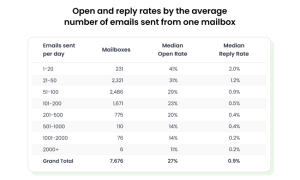
Several cold email tools, including Woodpecker, have already met the need to scale sending horizontally. You can connect as many mailboxes as you need without paying extra.
Woodpecker will automatically rotate the mailboxes, too, and keep the daily sending limits in check. You don’t have to keep an eye on that.
The switch to horizontal sending might also be a good time to take a closer look at your cold email infrastructure.
Dedicated cold email infrastructure
You should have a separate email domain and mailboxes to use only to send cold emails. You don’t want to use your company domain for that. That’s always been the case, too, and it’s still true.
But which email provider should you use – does that matter? Most of us still use Google, Outlook, GoDaddy or several others most popular ones.
They have all sorts of senders, though. And we at Woodpecker now see that young domains are sometimes put on IP addresses shared with suspicious senders (like scammers). Being on a shared IP like that will affect your deliverability, too.
New types of email providers, like Mailreef, handle this issue. They offer dedicated cold email infrastructures, including dedicated IPs and SMTP servers. Using a service like this, you won’t be sharing your IP and SMTP with anyone. That way, you’re fully in charge of how healthy your email infrastructure is going to be.
Early adopters of the services get automated:
- SPF, DKIM and DMARC records (you must have them if you don’t want your emails to land in spam folders)
- Email forwarding, and
- Custom-tracking domain set-ups
These services often offer unlimited inboxes. That makes following the horizontal scaling strategy affordable.
Sending cold emails: what to do so you don’t miss out
The cold email ecosystem might be changing, but one thing hasn’t. You still want to appear as human as possible in your cold emails.
Here’s how to do it the new way.
Your action point #4
Follow this checklist:
- Start sending cold emails horizontally – low volumes from many mailboxes and domains. Schedule 50 emails per day per mailbox. If you need to start sending more emails, you need more mailboxes. See a detailed explanation in this video:
- Does your cold email tool have an Inbox Rotation feature? Switch to one that does (like Woodpecker).
- Choose a tool that keeps your cold email volume within your email provider’s sending limits (*ekhm* like Woodpecker with Adaptive Sending *ekhm*). This way, your emails will keep going out, with no blocks from your provider.
- Check your sending IP address with AbuseIPDB to see if you share it with any shady agents.
- Consider using a dedicated cold email infrastructure. We’ve integrated Woodpecker with Mailreef. When you buy a mailbox, it automatically connects with Woodpecker.
Bottom line is – it’s still all about making your sending resemble human sending as much as possible.
And speaking of humans – with all this “tech emulating humans” what will our role be in all of this? Will the role of SDRs as we know it become a thing of the past?
The SDR role is evolving
The SDR’s role – as we see it now – is immediate sales. It’s to generate pipeline. Originally, though, the role was created in response to massive demand. Look at this awesome SDR timeline from Shawn Sease on LinkedIn:
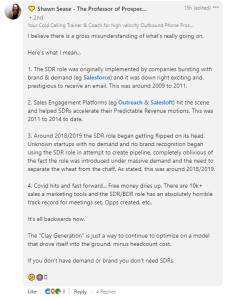
Indeed, when COVID hit and more businesses moved online, customer acquisition costs rose to record highs.
With costs going up and budgets getting tighter, businesses are looking for ways to increase profit without spending extra dollars. That means they try to do so without increasing the headcount.
And the rise of AI tech sure helps with that.
Will that really be just optimizing on a model that drove itself into the ground? Actually, it might just mean a shift in what SDRs focus on.
AI and automation will let SDRs become more customer-focused
The SDR role isn’t going anywhere. But it’s evolving big time.
You no longer need a team of 4 to spend hours on reaching out to prospects.
Tech-savvy SDRs can now handle the research, list building and cold email campaigns at a lower cost and in less time. They use tools like Woodpecker to automate the campaigns. If they also use AI and operationalization tools, one SDR can now manage the workload of 5 or 10 “old school” SDRs.
That doesn’t mean we won’t need SDRs anymore.
It means the role will become more customer-focused. It’s shifting to interactions and areas where human-to-human contact is essential.
SDRs will now get their time back to:
- Get a deeper understanding of your ICP and their current pain points
- Talk face-to-face with customers so they can build a better customer acquisition strategy
- Do broader tests and experiments on new markets and verticals
They might even become the voice of the customer within their company, sharing deep insights with other teams.
Given these changes, what do you need in a cold email tool so you don’t miss out?
To make your sending safe and effective, you need a cold email tool that:
- Keeps your email sending within limits. If you exceed them, your email provider will block your mailbox for some time
- Has built-in email validation to prevent high bounce rates. Email validation has always been free in Woodpecker. We don’t think our customers should have to decide whether it’s worth paying to send emails safely. Or if their budget allows them to spring for it.
- Allows you to scale with unlimited mailboxes for free
- Automatically rotates mailboxes and keeps the sending volume within limits. That way, you can send at scale, but your mailboxes don’t get blocked (or your domain burnt)
- Lets you track your email deliverability. That way, you can spot any potential issues before they ruin your sender reputation
- Sends your emails with a human-like sending randomization – so your email provider doesn’t mistake you for a spammer
- Checks your email copy for spam words to make sure it’s spam-words-free
- Is developed by a team of experts who’ve been in the cold email space for nearly a decade and are up-to-date with how the market changes
Try all of the above for free:
Cold email is not dead
Far from it. But if you won’t adjust to the shifting cold email ecosystem, you’ll lag behind.
Here’s a quick recap of the steps you can now take to thrive in the new way of cold emailing:
- Create more granular ICP segments with Clay or other data enrichment tool
- Use sales triggers for even better targeting
- Delegate prospect research to AI to get personalization at scale
- Create first email draft using AI, and tweak the copy
- Send horizontally: 50 emails per day per mailbox
- Consider using a dedicated cold email infrastructure
- Get a cold email tool that supports these changes
With these in your toolbox, you can double down on essential human-to-human parts of sales. Deeply understanding your customers’ stories and pain points will help you become a better partner in business. And that will make them want to stay with your company for years to come.

